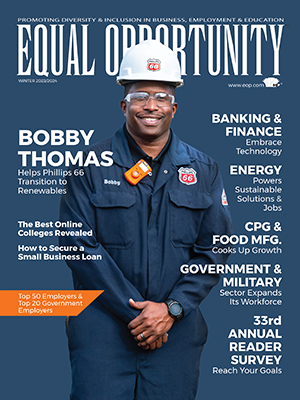| |

Equal Opportunity Magazine, launched in 1968, is a career-guidance and recruitment magazine offered at no charge to qualified African American, Hispanic, Native-American, and Asian-American college students and professionals in career disciplines. Equal Opportunity empowers readers to move ahead in their job search and/or current workplace environment.
This magazine reaches students and professionals nationwide at their home addresses, colleges and universities, and chapters of student and professional organizations.
If you are a student or professional who is a member of a minority group, Equal Opportunity is available to you FREE!

|
|
 Equal Opportunity
Equal Opportunity
» Featured Articles
» Subscription Information
» Reader Survey
» Companies Actively Recruiting

EFFECTIVES RÉSUMÉS: FACT AND FICTION
As the saying goes, you never get a second chance to make a first impression. Recruiting expert David Boggs, practice leader at WK Advisors, a division of executive search firm Witt/Kieffer offering mid-level executive search consulting services, sees hundreds of résumés, each week. Boggs has crystallized his experience in identifying a winning C.V. and offers five specific myths –and truths— about effective résumé, writing, and job searching:
Myth: The “summary” section is the only part of the résumé that potential employers really read.
Truth: “Don’t agonize over your summary,” says Boggs. “Pay more attention to the bullet points under each position—make sure they are detailed, yet clear and concise. Employers are looking for specific accomplishments that articulate the value you could bring to their organization. And for those of us with at least a decade’s worth of experience, a two-to-five-page résumé is just fine.”
Myth: The myth of the cover letter.
Truth: According to Boggs, your email is now the cover letter. “Not only is there no need for a separate cover letter, you may actually be confusing potential employers with too many documents,” he says. Make sure your email is tailored to the specific company you’re reaching out to, which leads us to….
Myth: You should share your résumé with everyone you meet.
Truth: Boggs encourages a targeted approach to job-seeking. “Take the vision of what you ideally want to be doing and identify the five-to-ten companies that you’re seriously interested in,” he says. “Then pursue them like, well, like it’s your job.”
Myth: Companies don’t want to hire unemployed jobseekers.
Truth: There is no longer an “unemployment” stigma, since these days so many great executives have been laid off. Says Boggs, “Always be honest and transparent, but more importantly, don’t see unemployment as a negative; and certainly don’t hide it.”
Myth: Social media is all you need.
Truth: “Actually,” says Boggs, “the old-fashioned way to network is still the most effective—in person. Take advantage of professional association events, get business cards and follow up. However, do link to your LinkedIn page on your résumé—it’s a great way to put all of your recommendations in front of potential employers. Also know that recruiters are looking at all social platforms to get a sense of your skills, not just LinkedIn. Make sure you’re posting industry trends and interesting stories relating to your area of expertise to Facebook, Twitter, even Instagram.”
 » Feedback for the Editor
» Feedback for the Editor
» Request Article Copy
|
|